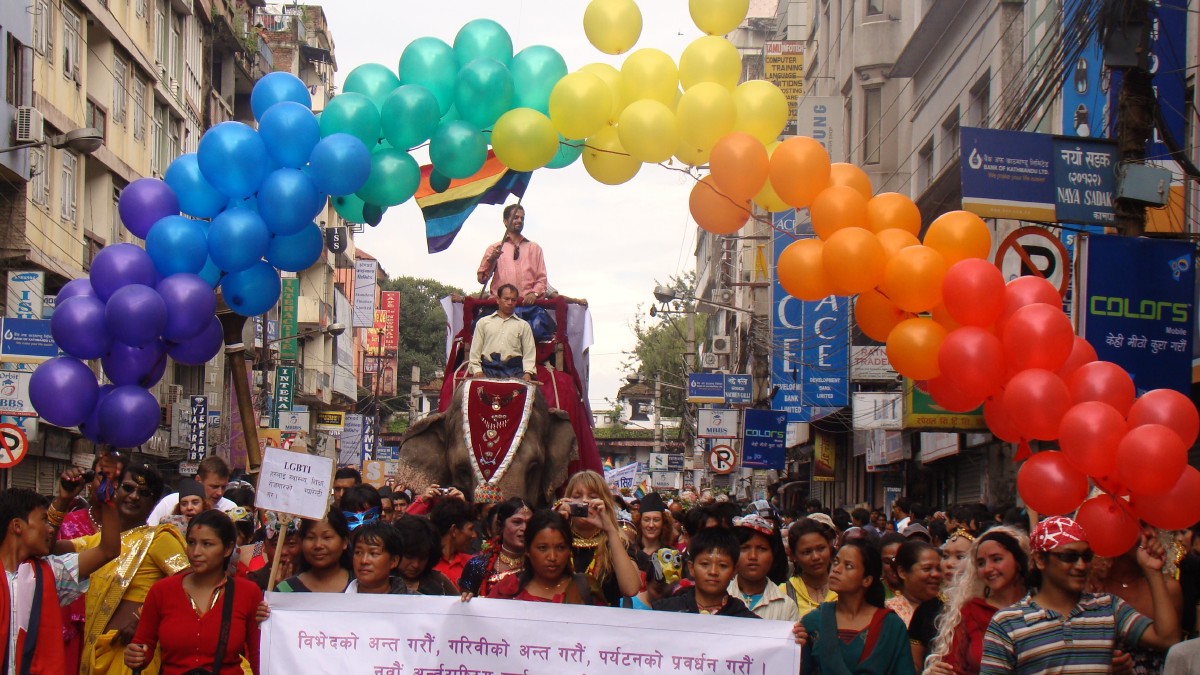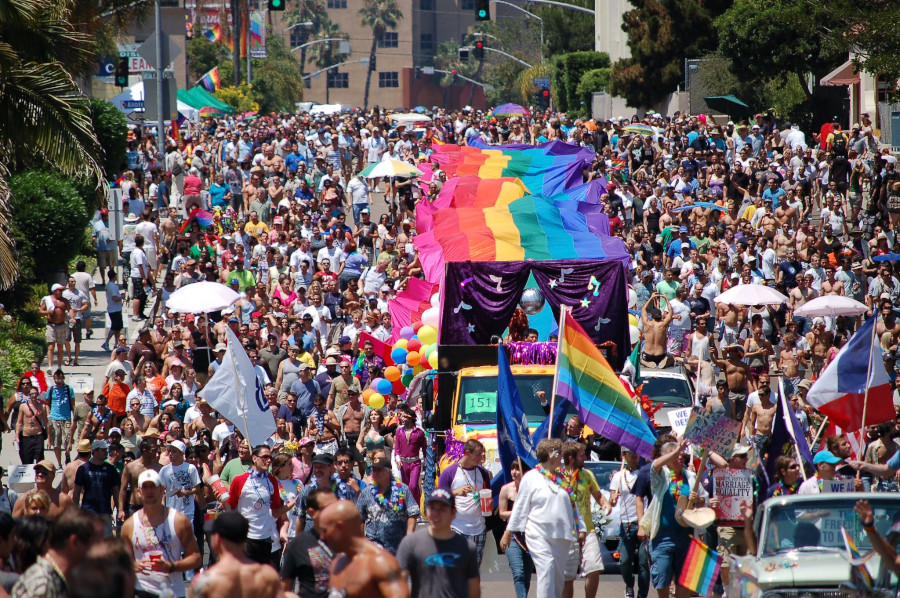Binary Compulsion: A dangerous gender myth, by Sunil Pant
The British Prime Minister, Rishi Sunak, shocked and dismayed so many of us with his defiant declaration at the Conservative party conference that “a man is a man and a woman is a woman, that's just common sense!” Seems he has never met masculine women or feminine men? Even more mind-boggling and disturbing - how is it even possible that an educated man of Hindu heritage can not be aware of the rich tradition of third-gender people in Asian countries?
 Gay Pride in Kathmandu
Gay Pride in Kathmandu
In response to this disgraceful attitude coming from a world leader we offer this article about gender categories in traditional Nepalese culture, written by Nepali film-maker and LGBTQI activist Sunil Babu Pant. Sunil was the first openly gay national-level politician in Asia: in 2001 he founded the Blue Diamond Society, Nepal’s first LGBTQI advocacy group. Six years later, he won a spectacular victory in that nation’s highest court with a ruling that LGBTQI Nepalis deserve equal rights and freedom from discrimination under the law, including the right to marry. Based on the high profile he earned during his court challenge, Pant, in 2008, became the first out LGBTQI individual elected to a national parliament in Asia. He is now a film-maker, his first feature, “Blue Flower {Striving for the Impossibility}” featured a Nepali tradition that traps many — gay men, lesbians, and others — in unhappy lives: forced marriage, the practice under which most young people are expected to enter into unions arranged by their parents. Earlier this year Sunil wrote this article - Binary compulsion: A dangerous gender myth (theannapurnaexpress.com) - about the traditional understanding of gender in Nepalese culture, in response to the Nepalese government adopting a western style medical view of gender transition.
Sunil wrote:
In Nepal, the term ‘third gender’ has been used, which is derived from the root word Tritiya Prakriti (‘person of third nature’ in Sanskrit language). There were more than two genders recognised in East and South Asia, and most of African and other indigenous societies until Christianity or Islam took over. Gender variant people have existed throughout the world and across time, celebrated in some cultures, denigrated in others. Some societies did not just recognize people who embodied a gender identity beyond the binary, for example, hijra, kothi, maruni, janana, nastri, napumshak communities in South Asia, two-spirit people among some Native American cultures, waria, kathoi in Southeast Asia and Fa’afafine in Pacific Islander communities, they were/are well-respected and had/have important roles, largely accepted by all, to play in society. While the blunt classificatory instruments of colonial rule imposed new and bureaucratic restrictions on gender assignment/self-identification, these communities persisted, and continue to this day to provide alternate ways of thinking about gender that evade the externally imposed binary classification.
Now, due to centuries of long and ardent missionary propaganda, and the role of the western media, these cultural influences are so strong that even these above-mentioned people of third nature don’t wish to use their traditional identity to introduce themselves, and often prefer the English word ‘transgender’. It’s important to note here that the word ‘third’ does not mean third in terms of a ranking order. Instead, it just means not so obvious, special, middle gender; something similar to the meaning when we say ‘the third eye’, indicating thereby merely the fact that there are more than two.
These communities of non-binary genders thus have to face a dilemma in their thinking process. Substituting western/modern words for the terms traditionally used to signify gender have become an easy way out for them, instead of accepting and living out who they are culturally conditioned to be bodywise, emotionally, and spiritually. Let’s try to understand with an example. What’s the thought when one says, “I am (born) in the wrong body.”? Where is this notion of the ‘wrong body’ coming from? What/who made you believe that you are in a ‘wrong body’? Who taught you and made you believe that some ‘other body’ is the ‘right body’ for you, instead of the one you were born with? Western theology and myths tell us that when God created the world (stars, sun, moon, rivers, valleys, trees, animals, food), he created a man (Adam). After a while, God realized that the man he created was lonely and needed a helper/companion. He decided to create a woman to help and entertain that man, Adam, and thus created a woman, Eve. Thus, according to Western faith/culture system (Christianity, Judaism, and Islam), God did not create any gender other than man and woman. This is at the very root of the binary that is being imposed today. This faith tradition impacts transgender persons adversely. It lays down that a male can only become a man, a female can only become a woman. Other options, whereby a male wishes to become a woman (or vice-versa), are seen as antithetical to the grand plan laid out by God. It’s thus understood as something that we mere mortals should not interfere with or tamper. To try to do so is variously seen as unnatural, sinful, and even criminal. But in Eastern faith traditions and culture systems there is no creator god! ‘Creation’ is not an exclusive phenomenon, and is instead an integral part of a long drawn out and cyclical process, wherein creation, its sustenance, and its destruction are all part and parcel of the same continuous long cycle and are intimately linked to each other. Thus, anything that has ‘existence’ is part of the magic of this eternal cycle, and there is no value judgment attached to it. Everything, and every phenomenon in nature is ‘natural’. Human beings are not competent to question this grand scheme, nor capable of attaching value-driven interpretations of right and wrong on natural phenomenons. Human beings become part of this cycle through their actions (Karma), and every consequence in the life of an individual is a result of their karma. Thus men, women, and several other genders are part of humanity and part of nature and existence. They all are living their own ‘karma’. Therefore, one cannot say that any one gender is better or ‘more right’ than any other gender. Hence, no one can be urged to become a man or a woman. One is what one is, naturally, as a consequence of past karma, and that’s that. Therefore, historically everyone was, (and still are in many indigenous communities) respected regardless of their gender and sexual identity. In the mid-19th century, Judaeo-Christian morality was given the imprimatur of ‘scientific pathology’, and homosexuality was classified as a mental illness. This happened likely under the influence of that set of biblical ideas wherein sodomy is sinful, women were created to help and entertain men, and copulation was sanctioned only within heterosexual matrimony (preferably in the missionary position).
 Until a few decades ago, and very much within recent memory, even in supposedly advanced and modern countries like the USA and the UK, homosexual people were diagnosed as mentally sick. Thus even the scientific edifice of modern society worked toward conditioning many gays and lesbians to start believing that they had a mental disorder. Many cruel and inhuman therapies, including electric shock therapy and overdoses of numbing drugs were administered to ‘change people’. Of course, since it was not ‘science’ but morality-driven prejudices that created the so-called pathology in the first place, none of these therapies actually worked. Since the early 80s of the last century, gay rights activists fought against such unscientific claims, and the harm such pseudo-sciences caused. As a result, homosexually was finally removed from the list of mental health disorders. The cycle of pain, suffering, and discrimination that gay men underwent, and their successful struggle to engineer change and claim their rights is today being replicated for persons whose gender identification defies the binary of man and woman and the straightjacketed roles assigned to each. The structures that contribute to creating dominant discourses and ideas are heavily influenced by the West, and sadly, it is still stuck with the pathologizing diagnosis of gender dysphoria attributed to those persons whose gender characteristics or features differ from the accepted binary of men and women. Not surprisingly this time too, it is driven by the same biblical belief, and Judaeo-Christian morality. Often the religiously leaning conservatives are at the forefront of driving this pseudo science. Such an unquestioned and faith-driven attitude is deep-rooted and strong. Under the influence of religious scholars, whose dominance in thought engineering has been at work for many many centuries, today many persons of differing gender characteristics and features themselves believe that they have gender dysphoria. They end up thinking that they are in the wrong body.
Until a few decades ago, and very much within recent memory, even in supposedly advanced and modern countries like the USA and the UK, homosexual people were diagnosed as mentally sick. Thus even the scientific edifice of modern society worked toward conditioning many gays and lesbians to start believing that they had a mental disorder. Many cruel and inhuman therapies, including electric shock therapy and overdoses of numbing drugs were administered to ‘change people’. Of course, since it was not ‘science’ but morality-driven prejudices that created the so-called pathology in the first place, none of these therapies actually worked. Since the early 80s of the last century, gay rights activists fought against such unscientific claims, and the harm such pseudo-sciences caused. As a result, homosexually was finally removed from the list of mental health disorders. The cycle of pain, suffering, and discrimination that gay men underwent, and their successful struggle to engineer change and claim their rights is today being replicated for persons whose gender identification defies the binary of man and woman and the straightjacketed roles assigned to each. The structures that contribute to creating dominant discourses and ideas are heavily influenced by the West, and sadly, it is still stuck with the pathologizing diagnosis of gender dysphoria attributed to those persons whose gender characteristics or features differ from the accepted binary of men and women. Not surprisingly this time too, it is driven by the same biblical belief, and Judaeo-Christian morality. Often the religiously leaning conservatives are at the forefront of driving this pseudo science. Such an unquestioned and faith-driven attitude is deep-rooted and strong. Under the influence of religious scholars, whose dominance in thought engineering has been at work for many many centuries, today many persons of differing gender characteristics and features themselves believe that they have gender dysphoria. They end up thinking that they are in the wrong body.
Eastern philosophy creates space for everyone, thus instead of problematising something that is natural, it creates a support structure that’s inclusive. Its terminology is also therefore inclusive. Third Gender is such a term. It breaks and extends the binary of man and woman to include those that are not. It therefore also fosters a society where it’s OK to be different. Occidental philosophy by contrast is about pathology and transformation, with the end goal being to conform to standards set by the outside. It’s not about acceptance and creating space for everyone, but about tampering to fit a pre-set mold. Thus also its terminology. ‘Trans’ means change. It seeks to tamper what’s naturally present, to change it. And to do this it convinces anyone who does not conform that they not only have a problem, but that they are a problem. It creates self conflicted mindsets.
For example, we can take the issue of transgender people’s participation in sports. The issue of sporting ethics arises because allowing transwomen to compete along with other women in sports seems to provide an unfair advantage to transwomen, but permission for transmen to compete along with men creates a distinct disadvantage for the majority of transmen. If one sees the fact that women’s sports was separated out from men’s sports because women’s and men’s physiologies are different, then one fails to see the logic of allowing transmen to compete in men’s sports and/or transwomen to compete in women’s sports. The only explanation that fits this insistence is that of the orthodoxy of gender binary, wherein everyone has to fit into one of the two set criteria, and even if ‘naturally existing’ in reality, a third (or fourth) category will not be acknowledged or created.
Many eastern, African, and other indigenous faiths and cultures have historically accepted, and some are still accepting, of more than two genders. In some cultures, 5 or even 7 genders have been acknowledged and accepted. In the Tantra tradition as practiced in the mountain regions, all these genders were considered divine. Every gender had/have their important roles to play in these societies. No one was/is considered sick, or weak, or diseased because their gender trait is different from the norm. It is a proper and unconditional celebration of gender diversity. To be born male but to grow up with feminine features and presentations if that is one’s nature is a cause of celebration. Similarly, to be born female and to grow with masculine features and presentations, if that is one’s nature is celebrated too. Intersexed people are/were considered having special devine powers and well-respected.
We see therefore that in these societies, unlike in the west, no one was/is needed to transit from their core self, their nature, their ‘prakriti’. One can simply be who one is and still be celebrated and valued. No one has to consider their natural state as being pathologically afflicted. The inherent human dignity of everyone is preserved and protected without interference. It is a culture where patriarchy has as much weight as matriarchy, and both are equally valued. The government of Nepal has introduced a policy that requires a medical certificate of sex change surgery if one wishes to apply for citizenship identity documents that recognise their gender as different from their sex at birth. One fails to understand why the government cannot find the moral courage to rely on the wisdom and inclusivity fostered by Nepal’s inclusive, rich, dignity-reinforcing customs, faith-traditions, and culture. It’s a misfortune of cultural genocidal proportions when a government is motivated by imported morality, customs, and ideas, to create legal frameworks that oppress its citizens, while ignoring the much better, inclusive and rights-affirming national traditions.
Original article can be found at https://theannapurnaexpress.com/news/binary-compulsion-a-dangerous-gender-myth-39968





